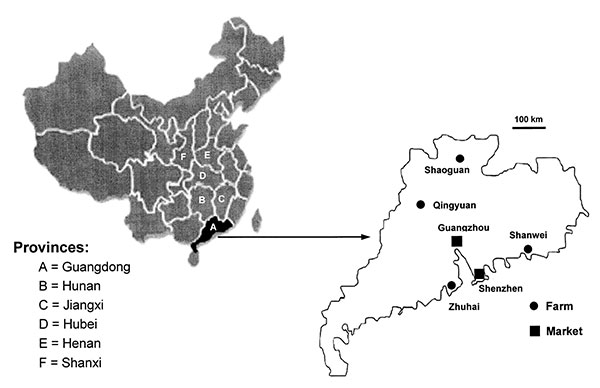Volume 10, Number 12—December 2004
Dispatch
Antibodies to SARS-Coronavirus in Civets
Figure

Figure. Geographic distribution of the farms and market examined in this study. The diagram on the left identifies the six provinces relevant to this study. The diagram on the right is an enlarged map of Guangdong Province showing the locations of the four farms and the capital city Guangzhou, where the live animal market was located. Also shown is Shenzhen, where civets from live animal markets were tested by Guan et al. in May 2003 (5).
References
- World Health Organization. Summary of probable SARS cases with onset of illness from 1 November 2002 to 31 July 2003. Geneva: The Organization; 2003 Sep 26 [cited 2004 Oct 14]. Available from http://www.who.int/csr/sars/country/table2003_09_23/en/
- Centers for Disease Control and Prevention. Prevalence of IgG antibody to SARS-associated coronavirus in animal traders—Guangdong Province, China, 2003. MMWR Morb Mortal Wkly Rep. 2003;52:986–7.PubMedGoogle Scholar
- Xu R-H, He J-F, Evans MR, Peng G-W, Field HE, Yu D-W, Epidemiologic clues to SARS origin in China. Emerg Infect Dis. 2004;10:1030–7.PubMedGoogle Scholar
- Guan Y, Zheng BJ, He YQ, Li XL, Zhuang ZX, Cheung CL, Isolation and characterization of viruses related to the SARS coronavirus from animals in southern China. Science. 2003;302:276–8. DOIPubMedGoogle Scholar
- Fouchier RA, Kuiken T, Schutten M, van Amerongen G, van Doomum GJ, van den Hoogen BG, Aeitiology: Koch’s postulates fulfilled for SARS virus. Nature. 2003;423:240. DOIPubMedGoogle Scholar
- Martina BEE, Haagmans BL, Kuiken T, Fouchier RAM, Rimmelzwaan GF, van Amerogan G, SARS virus infection of cats and ferrets. Nature. 2003;425:915. DOIPubMedGoogle Scholar
- Subbarao K, McAuliffe J, Vogel L, Fahle G, Fischer S, Tatti K, Prior infection and passive transfer of neutralizing antibody prevent replication of severe acute respiratory syndrome coronavirus in the respiratory tract of mice. J Virol. 2004;78:3572–7. DOIPubMedGoogle Scholar
- Wentworth DE, Gillim-Ross L, Espina N, Bernard KA. Mice susceptible to SARS coronavirus. Emerg Infect Dis. 2004;10:1293–6.PubMedGoogle Scholar
- Weingartl HM, Copps J, Drebot MA, Marszal P, Smith G, Gren J, Susceptibility of pigs and chickens to SARS coronavirus. Emerg Infect Dis. 2004;10:179–84.PubMedGoogle Scholar
- Watts J. China culls wild animals to prevent new SARS threat. Lancet. 2004;363:134. DOIPubMedGoogle Scholar
Page created: April 14, 2011
Page updated: April 14, 2011
Page reviewed: April 14, 2011
The conclusions, findings, and opinions expressed by authors contributing to this journal do not necessarily reflect the official position of the U.S. Department of Health and Human Services, the Public Health Service, the Centers for Disease Control and Prevention, or the authors' affiliated institutions. Use of trade names is for identification only and does not imply endorsement by any of the groups named above.